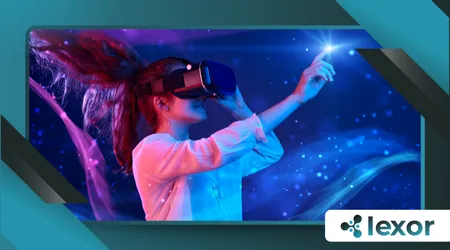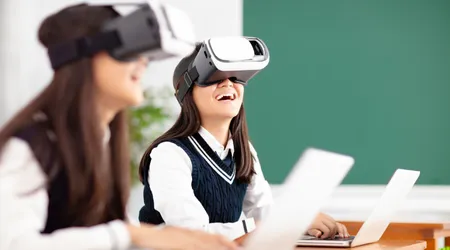The Future of Virtual Reality: What to Expect in the Next Decade

The future of virtual reality is no longer a distant dream—it’s unfolding before our eyes. By 2035, VR will redefine how we work, play, and connect.
What once seemed like science fiction is now a tangible reality, with advancements happening at an unprecedented pace.
From immersive gaming to life-saving medical applications, VR is poised to transform every facet of our lives. But what exactly can we expect in the next decade?
Let’s dive into the innovations, challenges, and opportunities that will shape the future of virtual reality.
The Evolution of VR: From Niche to Mainstream
Once confined to gaming, VR now permeates industries like healthcare, education, and retail.
Over 58 million VR headsets were sold globally in 2024, signaling mass adoption. This shift is driven by technological advancements and a growing recognition of VR’s potential.
Early VR systems were clunky and expensive, limiting their appeal. Today, sleek, affordable devices like the Meta Quest 3 and Apple Vision Pro have made VR accessible to millions.
This democratization is fueling innovation across sectors, from virtual classrooms to remote workspaces.
The next decade will see VR become as ubiquitous as smartphones. As hardware improves and content diversifies, VR will transition from a novelty to a necessity.
The future of virtual reality lies in its ability to seamlessly integrate into our daily lives.
+ VR Gaming Evolution: From Console to Full Immersion
Immersive Experiences Beyond Gaming

Gaming remains a cornerstone, but VR’s potential extends far beyond. Imagine attending concerts, exploring ancient ruins, or even practicing surgery—all from your living room.
These experiences are no longer hypothetical; they’re happening now.
For instance, platforms like Fortnite and Roblox are hosting virtual concerts featuring artists like Travis Scott and Ariana Grande.
These events attract millions of users, showcasing VR’s ability to create shared, immersive experiences.
Similarly, museums are using VR to offer virtual tours, allowing users to explore exhibits from anywhere in the world.
In the medical field, VR is revolutionizing training and treatment.
Surgeons can practice complex procedures in a risk-free environment, while patients use VR for pain management and therapy.
The future of virtual reality will see these applications become even more sophisticated, blurring the line between the physical and digital worlds.
+ How to Create a Tech-Friendly Learning Environment at Home
Social VR: Redefining Human Connection
Platforms like Meta’s Horizon Worlds are transforming social interactions.
Virtual meetups and collaborative workspaces are becoming the norm, bridging geographical divides.
This shift is particularly significant in a post-pandemic world where remote work and digital communication are here to stay.
Social VR isn’t just about avatars and chat rooms; it’s about creating meaningful connections.
For example, families separated by distance can gather in virtual spaces to celebrate milestones.
Similarly, businesses are using VR for team-building exercises and global conferences, fostering collaboration in ways that traditional video calls cannot.
As technology advances, social VR will become more lifelike. Imagine attending a virtual wedding where you can hug the bride or shake hands with the groom.
The future of virtual reality will make these experiences not only possible but commonplace.
The Role of AI in VR’s Growth
AI enhances VR by creating dynamic, responsive environments. From personalized avatars to real-time language translation, AI ensures seamless, immersive experiences.
This synergy is driving innovation across the board.
For example, AI-powered avatars can mimic facial expressions and body language, making virtual interactions more authentic.
Similarly, AI algorithms can adapt VR content in real-time based on user behavior, creating personalized experiences.
In education, AI-driven VR tutors can provide customized lessons, adapting to each student’s learning style.
In healthcare, AI can analyze patient data to create tailored therapy programs.
The future of virtual reality will be shaped by AI’s ability to make these experiences more intuitive and effective.
Table 1: VR Adoption by Industry (2024)
| Industry | Adoption Rate (%) |
|---|---|
| Gaming | 45 |
| Healthcare | 20 |
| Education | 15 |
| Retail | 10 |
| Other | 10 |
Hardware Innovations: Lighter, Faster, Smarter
Next-gen VR headsets are shedding bulk. Companies like Apple and Sony are prioritizing comfort, resolution, and wireless functionality, making VR accessible to all.
These advancements are crucial for widespread adoption.
For instance, the Apple Vision Pro features a sleek design and high-resolution displays, offering an unparalleled visual experience.
Similarly, Sony’s PlayStation VR 2 boasts advanced haptic feedback and eye-tracking technology, enhancing immersion.
The next decade will see even more breakthroughs. Foldable headsets, ultra-lightweight materials, and longer battery life are just a few of the innovations on the horizon.
The future of virtual reality depends on making these devices as user-friendly as possible.
The Rise of Mixed Reality
Blending physical and digital worlds, mixed reality (MR) is gaining traction. Devices like
Microsoft’s HoloLens 3 are paving the way for hybrid experiences.
MR combines the best of VR and AR, offering endless possibilities.
In retail, MR allows customers to visualize products in their homes before purchasing.
For example, IKEA’s MR app lets users place virtual furniture in their living rooms, ensuring a perfect fit.
In education, MR can bring textbooks to life. Imagine studying the solar system by holding a virtual planet in your hand.
The future of virtual reality will see MR become a powerful tool for learning and innovation.
Ethical Considerations in VR
As VR evolves, so do concerns about privacy and addiction. Striking a balance between innovation and user well-being is crucial for sustainable growth.
These challenges must be addressed head-on.
For instance, VR platforms collect vast amounts of user data, raising privacy concerns. Companies must implement robust security measures to protect this information.
Similarly, the immersive nature of VR can lead to addiction, particularly among younger users.
Regulatory frameworks and ethical guidelines will play a key role in shaping the future of virtual reality. By prioritizing user safety and transparency, the industry can build trust and ensure long-term success.
Table 2: Projected VR Market Growth (2025-2035)
| Year | Market Value (USD Billion) |
|---|---|
| 2025 | 35 |
| 2030 | 120 |
| 2035 | 300 |
VR in Education: A New Era of Learning

Classrooms are embracing VR to make learning interactive. Students can dissect virtual frogs or walk through historical events, making education engaging and effective.
This shift is transforming traditional teaching methods.
For example, Google Expeditions allows students to take virtual field trips to places like the Great Barrier Reef or the surface of Mars.
These experiences make learning more immersive and memorable.
The next decade will see VR become a standard tool in education. From kindergarten to higher education, VR will enhance learning outcomes and prepare students for a digital future.
The future of virtual reality in education is bright.
Also Read: Gamified learning: the power of educational games in modern education
Healthcare: Healing Through Immersion
VR is revolutionizing therapy and training. From treating PTSD to simulating complex surgeries, it’s proving to be a game-changer in medical fields.
These applications are saving lives and improving outcomes.
For instance, VR exposure therapy is helping patients with phobias and anxiety disorders.
By gradually exposing them to their fears in a controlled environment, VR enables effective treatment.
In surgical training, VR allows doctors to practice procedures without risking patient safety. This hands-on experience is invaluable for skill development.
The future of virtual reality in healthcare holds immense promise.
The Workplace of Tomorrow
Remote work is here to stay, and VR is enhancing collaboration. Virtual offices and 3D presentations are becoming standard, boosting productivity and creativity.
This shift is redefining the modern workplace.
For example, companies like Spatial are creating virtual meeting rooms where teams can collaborate in real-time.
These spaces mimic physical offices, complete with whiteboards and breakout areas.
As VR technology improves, the line between physical and virtual workspaces will blur. The future of virtual reality will make remote work more engaging and efficient than ever before.
Environmental Impact of VR
While VR reduces the need for physical travel, its energy consumption raises concerns. Sustainable practices in manufacturing and usage are essential. The industry must prioritize eco-friendly solutions.
For instance, VR data centers require significant energy to operate. Companies like Google and Microsoft are investing in renewable energy to offset this impact.
Additionally, recycling programs for VR hardware can reduce electronic waste. The future of virtual reality must balance innovation with environmental responsibility.
The Role of 5G and Cloud Computing
High-speed internet and cloud-based VR are eliminating latency issues. This synergy ensures smoother, more realistic experiences for users worldwide. These technologies are driving VR’s growth.
For example, 5G enables real-time streaming of high-quality VR content, making it accessible to more users.
Similarly, cloud computing allows for complex simulations without the need for powerful local hardware.
The next decade will see these technologies become even more integrated. The future of virtual reality depends on their continued advancement.
Also Read: The Rise of Virtual Reality Concerts: A New Era of Entertainment
Challenges Ahead: Accessibility and Cost
Despite advancements, affordability remains a barrier. Efforts to democratize VR technology are critical for its widespread adoption.
This includes addressing both hardware and content costs.
For example, initiatives like Meta’s subsidized headsets for schools are making VR more accessible. Similarly, open-source VR platforms are lowering development costs.
The future of virtual reality hinges on making it affordable for all. By reducing barriers to entry, the industry can ensure its long-term success.
The Cultural Shift: Embracing Virtual Lives
As VR becomes integral to daily life, societal norms will adapt. Virtual identities and economies will challenge traditional concepts of reality. This shift is already underway.
For instance, virtual real estate is a booming market, with users buying and selling digital properties. Similarly, virtual influencers are gaining popularity, blurring the line between reality and fiction.
The next decade will see these trends accelerate. The future of virtual reality will redefine how we perceive and interact with the world.
Conclusion: A Decade of Transformation
The future of virtual reality is bright, promising unparalleled innovation. By 2035, VR will not just augment reality—it will redefine it. From education to healthcare, the possibilities are endless.
This transformative journey hinges on collaboration between tech giants, policymakers, and users. Together, we can shape a future where virtual and physical worlds coexist harmoniously.
The future of virtual reality is not just about technology—it’s about humanity’s next great leap.
Frequently Asked Questions (FAQs)
1. What industries will benefit most from VR in the next decade?
Healthcare, education, and retail are expected to see significant growth, with applications ranging from virtual surgeries to immersive learning experiences.
2. How will AI enhance VR experiences?
AI will enable personalized avatars, real-time language translation, and adaptive content, making VR more intuitive and immersive.
3. What are the ethical concerns surrounding VR?
Privacy, data security, and addiction are key concerns. Addressing these issues is crucial for sustainable growth.
4. How will VR impact remote work?
VR will enhance collaboration through virtual offices and 3D presentations, making remote work more engaging and efficient.
5. What role will 5G play in VR’s future?
5G will enable real-time streaming of high-quality VR content, reducing latency and improving user experiences.
